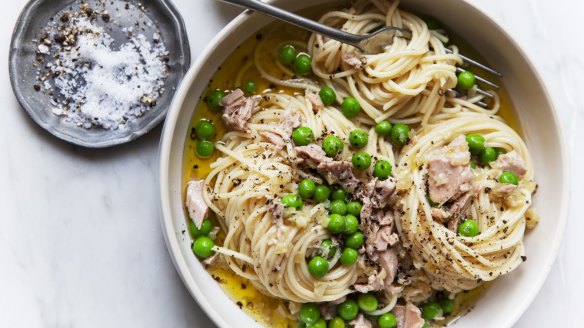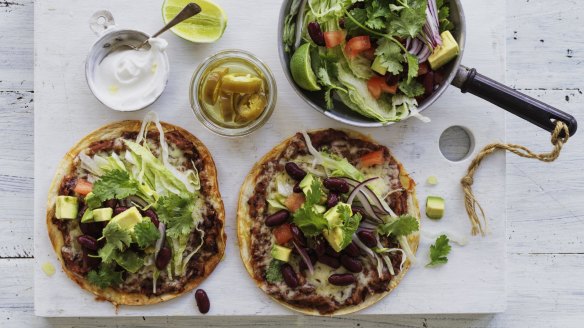Tips for making nutritious, budget-friendly meals using canned and frozen foods

-
Canned tuna and frozen pea spaghetti recipe (pictured)
Nutrition may not always be top of mind during a global pandemic, because many people are eating whichever foods they can access and afford. What's most important right now is to stay fed. But rest assured that even if you need to rely mostly on canned or frozen foods as you remain at home, you can create delicious and nutritious meals for your family.
"The good news about cooking with canned and frozen foods is that they can be just as nutritious as fresh varieties, and sometimes even more nutritious," says Karman Meyer, a dietitian and recipe developer at thenutritionadventure.com in Nashville.
Here's some basic information about canned and frozen foods, and how you can combine them with other pantry staples to make nutritious and affordable meals.
Canned goods
With a shelf life of up to five years, cans are excellent pantry staples. Steel cans have an airtight seal to guard against foodborne illness and contamination, and they are heated after packing to prevent spoiling, which kills bacteria. Although the heat treatment can destroy some vitamin C, it also boosts antioxidant content. The canning process increases the amount of the antioxidant lycopene in canned tomatoes, for example.
"Canned tuna and salmon, mandarins, whole peeled tomatoes and beans are a few of the canned staples you will always find in my pantry," says dietitian and chef Whitney Reist, who adds that canned foods are just as nutritious as fresh ones. A comparison study funded by the Can Manufacturers Institute shows that canned goods, especially vegetables and fruit, cost less than their fresh or frozen counterparts.
"Canned foods are preserved at the peak of freshness without using additives and use the same techniques that you would employ to can or preserve in your own home kitchen," Reist says. She also notes that people who eat canned foods frequently are more likely to get the amounts of fibre, vitamins and minerals they need each day.
Even before the coronavirus, 90 per cent of Americans said they use canned beans, chicken or fish as a convenient source of protein. Any of these can be used in sandwiches, to make dips, top salads or to add to soups and stews.
Dietitian and chef Ranelle Kirchner says she grew up on canned foods and always has canned beans, corn and mushrooms in her pantry. She recommends buying canned foods that are low in sodium when possible. "You can use herbs and spices to add flavour and minimise the need for salt," Kirchner says.
Reist recommends rinsing the liquid off canned vegetables so they don't taste too salty in meals. Rinsing canned vegetables can reduce sodium content by up to 41 per cent.
You can also find a variety of nutritious, shelf-stable goods in containers other than cans, including jars (think peanut butter and tomato sauce), and aseptic cartons, often used for non-dairy milks, soups and tofu. Peanut butter lasts for about 12 months (unopened) in the pantry, or six to eight months once opened (and refrigerated). Foods in aseptic packages (think shelf-stable almond milk) are as safe as canned foods. The food is put into sterilised containers, then hermetically sealed with a sterilised closure to prevent bacterial contamination. Bonus: Aseptic-packaged food has an even longer shelf life than canned goods, plus better nutritional and sensory properties.
Frozen foods
Freezing is one of the most common methods of food preservation. Once a food is frozen, there's no water available for microbial development, which means bacteria can't grow. This gives frozen foods a long shelf life. Vegetables last for eight months in the freezer, while fruit lasts 12 months. Meat and poultry can be frozen for up to one year, lean fish or seafood for six months, and fattier fish such as salmon for three months.
Because vegetables and fruits are processed immediately after harvesting, nutrient losses are minimal. "Frozen fruits and vegetables are picked at the peak of freshness, then flash-frozen to maintain nutritional quality until used in your home," Meyer says. Studies show that frozen vegetables and fruit have the same amount – and sometimes even higher quantities – of vitamins, minerals and fibre, when compared with fresh produce.
Kirchner says she always has corn, edamame and a variety of fruit in her freezer. My convenient favourites include frozen peas, leafy greens, prawns, fish, chicken, meatballs and bread.

Budget-friendly meal ideas
With a few other pantry staples, you can create nutritious, tasty and affordable meals that start with canned or frozen items. Here are a few suggestions for a family of four to get you started.
- Try combining a box of wholemeal spaghetti with two cans of chickpeas , a can of diced tomatoes and frozen spinach to make a super pasta dish on a budget. Or swap the chickpeas for two cans of tuna. Sprinkle with dried basil for a flavour boost, and add some parmesan cheese if you have it.
- Or, pair frozen corn kernels with a can of black beans and a can of tomatoes, then roll this mix in eight wholemeal tortillas. Add some herbs and spices from your pantry, such as dried oregano, chilli powder and ground cumin. If you don't have the tortillas handy, serve the bean, corn and tomato mixture over four cups of cooked rice instead.
- A can of creamy mushroom is a great start for a simple tuna casserole. To a baking dish, add soup, cooked macaroni, two cans of tuna and frozen peas, then top with a cup of shredded cheddar cheese, and bake at 200C for 30 minutes.
- Tomatoes, rice, beans and onions work beautifully together. If you have these staples on hand, add two cups of dry rice, one 400g can of tomatoes, one diced onion and one cup of water to a pot. Season with salt and pepper, and add your favourite spice blend, such as chilli powder, curry powder or Italian seasoning. Simmer until liquid is absorbed and rice is tender, about 10 to 15 minutes. Add one can of drained and rinsed black or kidney beans, and enjoy.
- If you have a cooked chicken breast, try making the ultimate comfort food, chicken noodle soup. Add some butter or oil to a large pot, and saute two cups of mixed fresh or frozen vegetables, such as carrot, celery, onion or parsnip, for five minutes. Add eight cups of water or chicken stock and shredded chicken, and bring to a boil. Add two cups of any small pasta shape, and boil until the pasta is. Add salt and pepper to taste, and serve hot.
Rosenbloom is a registered dietitian and the co-author of Nourish: Whole Food Recipes Featuring Seeds, Nuts and Beans.
The Washington Post